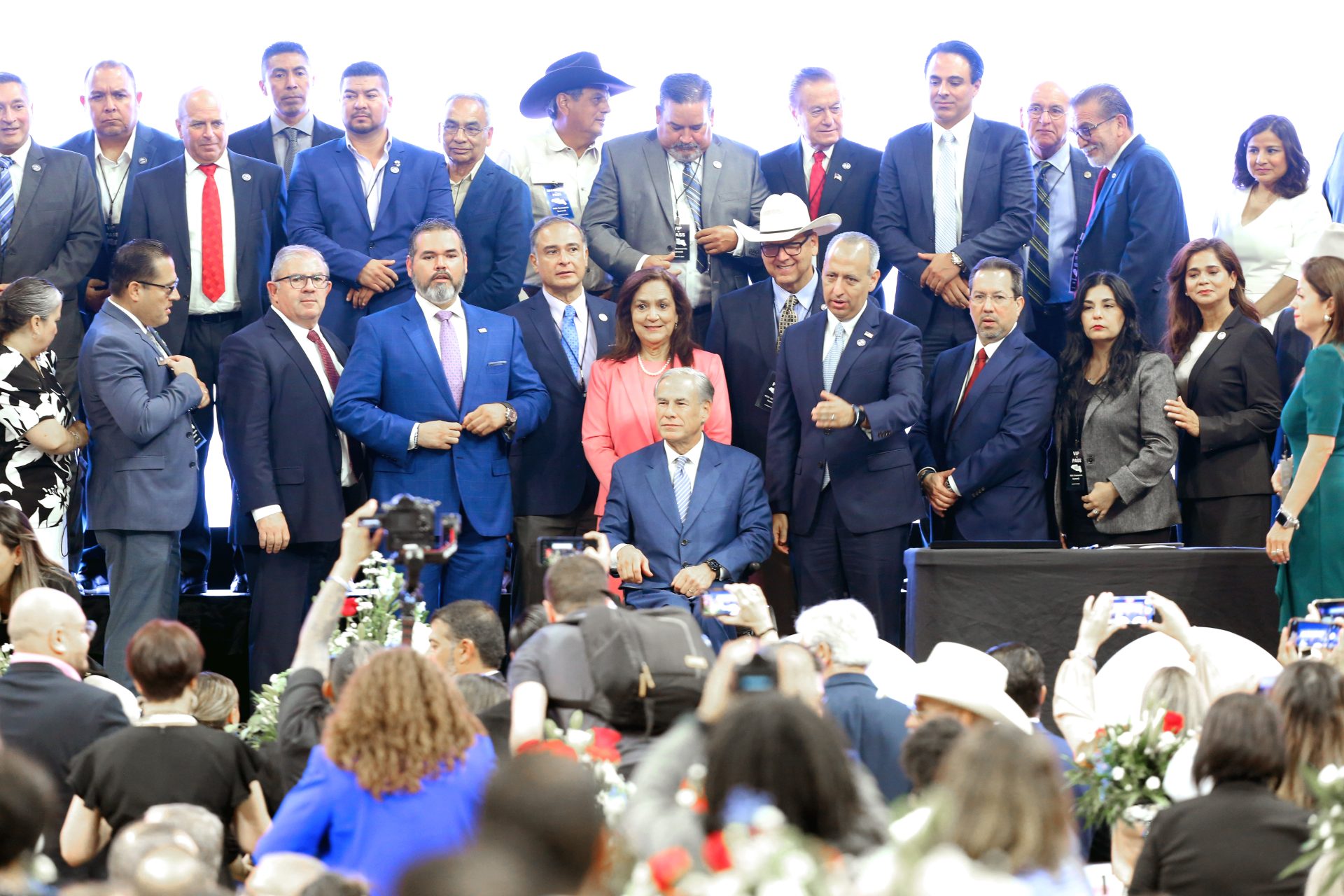EDINBURG — It was momentous occasion here Wednesday as representatives from all four of the Rio Grande Valley’s counties met to deliver a “state of the Valley” address during a luncheon hosted by the RGV Hispanic Chamber of Commerce.
The panel discussion featured Hidalgo County Judge Richard F. Cortez, Cameron County Judge Eddie Treviño Jr., Starr County Judge Eloy Vera and Precinct 4 Willacy County Commissioner Ernie Garcia, who stood in for Willacy County Judge Aurelio “Keter” Guerra.
Moderating the discussion was Julian Alvarez III, the Hispanic Chamber’s vice chair of government affairs, and onetime labor commissioner with the Texas Workforce Commission.
The four county leaders spoke on everything from economic development to education, industry to immigration, and energy to health care.
But above all else, the four men spoke of the ties that bind the Valley’s counties together — of a growing culture toward regional thinking that has, in large part, been what’s propelled the region forward in recent years.
“What we’ve realized — and I think the proof is in the pudding — is that, by working together these last several years … has really reaped benefits for the entire RGV,” Treviño said.
“All of us are gonna advocate for that community that we serve, particularly, but that doesn’t mean that we do it to the detriment of our neighbors,” he added.
Some moments later, Vera, of rural Starr County, reiterated that sentiment.
“There is very good communication throughout the Valley. And ‘one region, one voice’ — and we need to keep it that way,” Vera said, echoing the creed of an RGV Partnership economic initiative that got the attention of Texas Gov. Greg Abbott in 2023.
 Gov. Greg Abbott, center, poses with local city mayors and other government leaders at the RGV Economic Summit at Bert Ogden Arena on Thursday, Aug. 17, 2023, in Edinburg. (Joel Martinez | jmartinez@themonitor.com)
Gov. Greg Abbott, center, poses with local city mayors and other government leaders at the RGV Economic Summit at Bert Ogden Arena on Thursday, Aug. 17, 2023, in Edinburg. (Joel Martinez | jmartinez@themonitor.com)Regional thinking is equally important in Willacy County, whose population of 20,000 is just one-third the size of Starr County, Garcia added.
“Although geographically, we’re a lot smaller than Cameron and Hidalgo and Starr … we do want to be key players with all the efforts that are being made in our counties,” the Willacy County commissioner said.
“We do also believe in the regional approach,” Garcia added.
Shifting mindsets from a “Friday night mentality” to a regional mentality has allowed the Valley to reap huge rewards, Treviño said.
One of the biggest examples of that is transportation.
Thinking regionally has allowed Cameron County to turn plans for a second causeway connecting South Padre Island to the mainland from a county-led project with an exorbitant and nearly unfeasible local price tag, to a state-funded project.
“The state of Texas will be picking up the tab,” Treviño said.
Further, the causeway will one day connect much further inland to Laguna Vista.
“There will be a new state highway from the second causeway to where? To Edinburg,” Treviño said triumphantly, adding that the proposed connector will make it possible for Hidalgo County residents to get to the Island in under an hour.
But the Cameron County judge also spoke of the giant strides that regional thinking — and the Valley’s prime location — has made in attracting high-dollar industries here.
 Starr County Judge Eloy Vera, right, Hidalgo County Judge Richard Cortez, left, and Cameron County Judge Eddie Treviño Jr., center, have a discussion at the table before the start of the RGV Hispanic Chamber of Commerce State of the RGV Luncheon at the Edinburg Conference Center at Renaissance on Wednesday, Jan. 15, 2025, in Edinburg. (Joel Martinez | jmartinez@themonitor.com)
Starr County Judge Eloy Vera, right, Hidalgo County Judge Richard Cortez, left, and Cameron County Judge Eddie Treviño Jr., center, have a discussion at the table before the start of the RGV Hispanic Chamber of Commerce State of the RGV Luncheon at the Edinburg Conference Center at Renaissance on Wednesday, Jan. 15, 2025, in Edinburg. (Joel Martinez | jmartinez@themonitor.com)For Cameron County, that has meant multi-billion dollar investments — and new jobs — from SpaceX and the liquefied natural gas industry.
“SpaceX, as you all know, has grown by leaps and bounds. … In addition to bringing the attention and the jobs, now they’re also discussing the fact of moving their headquarters from California to Cameron County,” Treviño said.
The Cameron County energy industry has also been booming.
“The NextDecade project is the largest privately funded project, investment, in the entire United States — over $18 billion, (and) anticipated, once they keep going … of upwards of $26-$30 billion,” Treviño said of the LNG export terminal being built at the Port of Brownsville.
But it’s not just Cameron County that has garnered the attention of energy companies.
Recently, Starr County has become home to “the largest solar farm in the state of Texas,” Judge Vera said.
And anyone who has driven north along Highway 77 has seen the dozens of wind turbines dotting the farm fields in Willacy County.
“We try to stay on the forefront of that kind of technology and innovation, although on a smaller scale,” Garcia added, referring to new electric battery farms that are also coming to his county.
But for all the positives the four county officials had to brag about, they also shared some of the issues that concern them most.
Judge Cortez spoke of the perniciousness of poverty that has plagued even the region’s largest county, Hidalgo, for the last five decades.
 Hidalgo County Judge Richard F. Cortez speaks to local leaders about his prosperity task force, which aims to lift residents out of poverty through a pathway of education, mentorship and job placement. (Dina Arévalo | darevalo@themonitor.com)
Hidalgo County Judge Richard F. Cortez speaks to local leaders about his prosperity task force, which aims to lift residents out of poverty through a pathway of education, mentorship and job placement. (Dina Arévalo | darevalo@themonitor.com)That’s namely what prompted him to start what he calls the “Prosperity Taskforce” in 2023.
“We want to identify people that need that training. We want to give them a path so that they can earn a better wage,” Cortez said.
Over in Starr County, new investments in education from UTRGV and South Texas College have allowed the rural county to make some dramatic dents in its unemployment numbers.
But there’s still more work to be done.
“At one time, (in) Starr County, unemployment hovered around 30-35%. … Now we’re down to about an 8% unemployment, which is still high, but we still continue to work on that,” Vera said.
Living along the border presents other unique challenges, the county leaders said.
For Vera, he’s curious what will happen with a 1,400-acre plot of land that was recently purchased by the Texas General Land Office.
Last month, Land Commissioner Dawn Buckingham offered the land to the incoming Trump administration for use as a migrant deportation center.
On Wednesday, Buckingham announced that the GLO had finished building 1.5 miles of border wall on the land.
“How is that going to affect us in Starr County?,” Vera asked.
“If it’s gonna create jobs and, I guess, grow our economic development, certainly we’re for it. If it’s gonna hinder it then, of course, we’re gonna oppose it.,” he added.
For Treviño, all the political rhetoric on the border has focused on the wrong thing.
“First of all, I completely, 100%, wholeheartedly disagree with the premise that the border is insecure,” Treviño said.
“I think it’s dishonest and it’s (a) slap in the face to the unbelievable job that our federal and state and local enforcement officials do to protect us and provide us a quality of life and safety that all of us have here,” he added.
Instead, the Cameron County judge wishes state and federal officials would focus their messaging on binational trade, and the billions of dollars in revenue it brings not only to the Valley, but to the country at large.
 Starr County Judge Eloy Vera, right, talk with guests during the RGV Hispanic Chamber of Commerce State of the RGV Luncheon at the Edinburg Conference Center at Renaissance on Wednesday, Jan. 15, 2025, in Edinburg. (Joel Martinez | jmartinez@themonitor.com)
Starr County Judge Eloy Vera, right, talk with guests during the RGV Hispanic Chamber of Commerce State of the RGV Luncheon at the Edinburg Conference Center at Renaissance on Wednesday, Jan. 15, 2025, in Edinburg. (Joel Martinez | jmartinez@themonitor.com)However, after more than an hour of discussion on topics far and wide, not one of the county leaders had mentioned what was one of 2024’s biggest newsmakers — something that will continue to be an issue this year — water.
No one mentioned it, that is, until Dante Galeazzi, president and CEO of the Texas International Produce Association asked during a public question-and-answer period at the end of the luncheon.
“Unfortunately, we didn’t hear anything about it, and it’s an issue that impacts all four counties. Without water we can’t do anything,” Galeazzi said.
In response, the four county leaders spoke of the gargantuan task of addressing the water scarcity crisis.
It’s imperative for the federal government to do more to get Mexico to uphold its obligations under a 1944 binational water sharing treaty with the United States, Vera said.
For Treviño, one of the biggest hurdles will be finding the funding to overhaul an irrigation canal-based distribution infrastructure that dates back to when the treaty was signed.
And for Garcia, whose rural county is among the last in line to receive water from the Rio Grande, it’s incumbent upon local governments to invest in alternative water sources, such as ground water and desalination plants.
But, Treviño also noted that none of the four county governments themselves serve as water suppliers. Instead, the task falls to individual municipalities, and irrigation and water supply corporations.
“Our goal is to help coordinate,” Treviño said.
Coordination is something Judge Cortez also mentioned in his response to the question.
The Hidalgo County judge said he’s considering issuing an emergency order that would result in the implementation of further water conservation efforts here.
Additionally, Hidalgo County is expecting to receive funding to help further study the crisis.
“I believe we’re about to receive a grant in excess of $700,000 from the NADBank that will help us study the situation and give us ideas as to what our alternative sources of water (are),” Cortez said.
“But we hear you. We understand perfectly well. But I hope no one here in this room believes that there’s a quick solution to the problems that we have, because there isn’t.”
The post County judges talk ‘state of the Valley’ at Hispanic Chamber luncheon appeared first on MyRGV.com.
 (2).png)
 2 hours ago
12
2 hours ago
12








 English (US)
English (US)